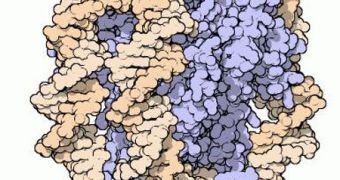The arrangement of nucleosomes inside cells, and the reason why they look like pearls on a necklace, are no longer a mystery for researchers.
Scientists finally managed to make sense of these aspects related to cellular genomes, which have been puzzling them for many years, AlphaGalileo reports.
Nucleosomes are protein particles which provide a support scaffolding of sorts for the DNA genome of organisms complex enough to possess cellular nuclei.
The genetic information wraps around these nucleosomes, which are themselves connected through flexible segments of the nucleic acid. As such, the entire structure looks like a row of pearls on a string.
This particular type of arrangement is not random, experts say. Apparently, it plays a rather important role in determining which genes get expressed at any given time.
This means that the arrangement controls which proteins are produced, and therefore which cellular or bodily processes are allowed to continue, and which are terminated.
Now, German researchers from the Ludwig-Maximilians-Universitaet (LMU), in Munich, managed to develop an advanced model for explaining the distribution of the nucleosomes around transcription start sites.
These are the spots in the arrangement where the expression of a gene, and the synthesis of a protein, begin. The work was led by LMU biophysicists and professors Ulrich Gerland and Wolfram Moebius.
“Our model provides a useful tool for dissecting the so-called chromatin code, which determines how the DNA is packed and selectively made accessible for transcription,” explains Gerland.
The expert is one of the authors of a new paper detailing the findings, which appears in the August 19 issue of the open-access scientific journal PLoS Computational Biology, a publication of the Public Library of Sciences.
“[The nucleosomes] have a decisive influence on gene regulation, insofar as they help to control which segments of the DNA can be translated into proteins,” adds Gerland.
He holds joint appointmest in the LMU Munich Physics Faculty Arnold Sommerfeld Center for Theoretical Physics (ASC), and the Center for NanoScience (CeNS).
“Our calculations should certainly help to decode the so-called chromatin code, the basis for which is not well understood. This code provides the blueprint for the three-dimensional structure of the genome,” the expert concludes.

 14 DAY TRIAL //
14 DAY TRIAL //